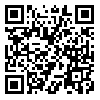Volume 25, Issue 2 (2021)
CLR 2021, 25(2): 77-105 |
Back to browse issues page
Download citation:
BibTeX | RIS | EndNote | Medlars | ProCite | Reference Manager | RefWorks
Send citation to:



BibTeX | RIS | EndNote | Medlars | ProCite | Reference Manager | RefWorks
Send citation to:
Sadeghi A, Gholampour M. Evaluating the Process of Classifying Prisoners in the Iranian Criminal Justice System with a Comparative Approach. CLR 2021; 25 (2) :77-105
URL: http://clr.modares.ac.ir/article-20-53321-en.html
URL: http://clr.modares.ac.ir/article-20-53321-en.html
1- Assistant professor of criminal law & Criminology, Faculty of law and political science, Mazandaran UniversityBabolsar, Iran. , az.sadeghi@umz.ac.ir
2- Ph.D. of criminal law & Criminology, Tarbiat Modarres University, Tehran, Iran
2- Ph.D. of criminal law & Criminology, Tarbiat Modarres University, Tehran, Iran
Abstract: (1669 Views)
Criminologists have always believed that the classification of prisoners can improve the effectiveness of the prison, if it is based on the rehabilitation theory. By implenting this process, prison security can be secured and prisoners will have access to treatment programs. For these reasons, criminal justice authorities have also focused on evaluating and strengthening the classification system. Given the importance of the issue, the present study aims to study the process of classification of prisoners in the Iranian criminal justice system with a comparative approach. To do this, two research methods of document analysis and in-depth interviews (with prisoners and prison staff) have been used. The findings indicate that despite the changes done by new regulation in 1400, there is considerable discretion in distributing prisoners, and even practices determine the re-classification of prisoners. In addition, prison population inflation has affected the classification of criminals and even changed the function of open and semi-open prisons.
Keywords: Classification of Prisoners, Closed Prison, Open and Semi-Open Prison, Objective Classification, Prison Population Inflation.
Article Type: Original Research |
Subject:
Comparative Law
Received: 2021/06/15 | Accepted: 2021/11/16 | Published: 2021/11/22
Received: 2021/06/15 | Accepted: 2021/11/16 | Published: 2021/11/22
Send email to the article author
| Rights and permissions | |
 |
This work is licensed under a Creative Commons Attribution-NonCommercial 4.0 International License. |








